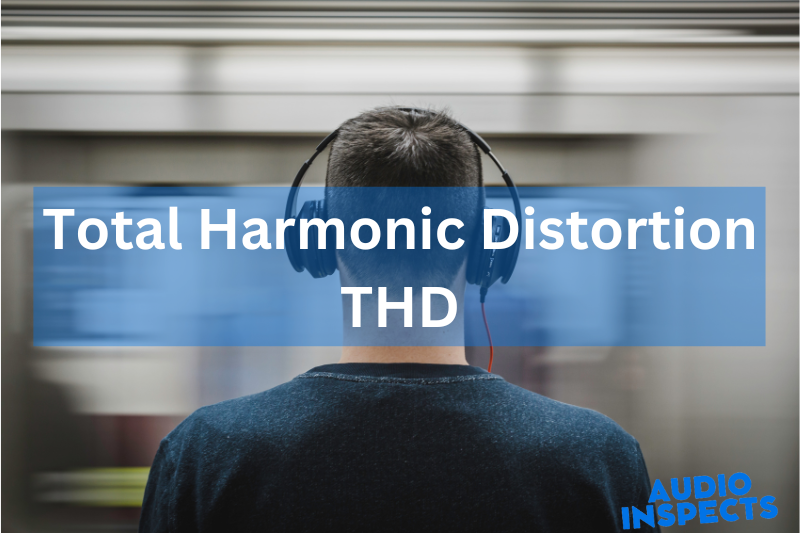What is Total Harmonic Distortion (THD) in Headphones

We conduct independent testing and research of products, so you can make an informed decision before making a purchase. And when you do decide to make a purchase through our links, please note that we may earn a commission, but this does not affect the honesty of our reviews.
Audio enthusiasts understand the importance of headphones when it comes to a great listening experience. However, most are unaware that there is something called total harmonic distortion (THD) present in headphones and how it affects the sound quality. This article will provide an overview of THD and its implications for headphone users.
What is Total Harmonic Distortion (THD)?
Total harmonic distortion (THD) is the measure of electrical signal distortion caused by the introduction of additional harmonics. Essentially, any device which adds or introduces disturbance to an audio signal can distort it, creating “harmonics” which create a less accurate representation of what was originally transmitted. Headphones are no exception – they too can create harmonic distortion due to factors such as their design and build quality.
How Does THD Affect Sound Quality?
The quality of sound produced by headphones with higher levels of THD tends to suffer greatly due to various factors such as increased noise levels, reduced clarity, decreased dynamic range, and more muted highs and lows.
Headphone models with lower Total Harmonic Distortion (THD) values are preferred by listeners, according to a study conducted by the Audio Engineering Society. The study found that listeners were able to distinguish between headphones with higher and lower THD levels and that they generally preferred those with lower THD levels. This was especially true for headphones with higher frequencies, where the difference in sound quality was more noticeable.
The study also found that the type of headphones used affected the listener’s preference. Open-back headphones were found to be more popular than closed-back models, as they allowed for a more natural soundstage and better imaging. Additionally, headphones with larger drivers were found to produce better sound quality than those with smaller drivers.
Overall, it is clear that headphone models with lower THD values are preferred by listeners due to their improved sound quality. It is important to consider this when choosing a pair of headphones, as it can make a big difference in your listening experience.
As such, audio enthusiasts should strive to purchase only headphones with low THD values to enjoy a richer and fuller sound performance from their audio devices.
Measuring Total Harmonic Distortion (THD) Values in Headphones
Fortunately, measuring the amount of THD present in a particular pair of headphones is relatively easy these days; most manufacturers include this information on product specifications or even include a graph on their website that illustrates the frequency response curve for each model with accompanying THD values at different frequencies (i.e., bass, mid-range and treble).
It is thus important for buyers to pay close attention to this information before making a purchase decision so that they can be sure they are getting their money’s worth when purchasing new headphones or upgrading existing ones.
Calculating Total Harmonic Distortion
Calculating total harmonic distortion (THD) is a relatively simple process that involves measuring the output of an audio device and determining the amount of distortion present. The best way to do this is to use an oscilloscope or analyzer, as these devices can measure the amplitude and phase of each frequency component present in a signal.
The procedure for calculating THD involves inputting the desired stimulus into the device to be tested, then measuring the output frequencies with an oscilloscope or analyzer. This will tell you how much distortion is present in your system. To calculate the exact value for THD, you need to take the ratio between the sum of all harmonic components and the fundamental frequency component.
It is important to note that calculating THD should be done under controlled conditions, such as in a soundproof room or other environments where extraneous noise can be minimized. Additionally, it is important to keep in mind that THD values can vary depending on many factors, such as amplifier design and speaker type.
Total Harmonic Distortion Formula
The formula for calculating total harmonic distortion (THD) is as follows:
THD = 20 * log10 (1/ √(1 + Σ P_i^2))
where P_i is the power of the ith harmonic component. This equation can be used to calculate the percentage of distortion present in a signal from its harmonics. It is important to keep in mind that this formula does not take into account any noise or other interference that may be present in the signal. Additionally, it should only be used as an approximation, as there are more complex methods available for accurately measuring THD values.
How to Reduce Total Harmonic Distortion?
Reducing total harmonic distortion (THD) requires an understanding of the underlying causes. Several factors can affect THD levels, including the design and build quality of the headphones, as well as the materials used in their construction. Here are some tips for reducing THD in your headphones:
- Choose headphones with a high-quality design and build. Look for models made from durable materials such as metal or aluminum.
- Avoid using cheap cables and connectors with your headphones. Cheap wires can lead to increased levels of THD due to impedance issues.
- Upgrade the earpads on your headphones if they are made of poor-quality material such as foam or artificial leather, as these can degrade sound quality.
- Remove any dust or debris from around the drivers of your headphone to ensure optimal performance.
- Make sure that your audio source is free from any kind of interference or distortion by using a good quality DAC or amplifier when playing digital music files.
FAQs
Conclusion
In conclusion, total harmonic distortion (THD) is an important factor to consider when it comes to purchasing a pair of headphones. As mentioned earlier, high levels of THD can lead to poorer sound performance due to increased noise levels, reduced clarity, etc.; whereas lower levels result in better overall sound quality.
Therefore, audio enthusiasts should always ensure to check out the manufacturer’s specifications or frequency response curve chart before buying new headphones so that they get the best possible experience out of their investment.
Related articles
- The Ultimate Headphones Buying Guide
- What Is Noise Cancellation On Headphones?
- What Is Frequency Response?
- What is Impedance for Headphones and Why Does It Matter?
- Sound Pressure Level (SPL)
Our Mission: At AudioInspects, we are dedicated to providing the most comprehensive and authentic reviews of audio equipment on the market. We conduct independent testing and research of products, so you can make an informed decision before making a purchase. Our mission is to help you find the best audio equipment to improve your listening experience. So trust us to deliver the most reliable recommendations and advice.
Disclosure: When you do decide to make a purchase through our links, please note that we may earn a commission, but this does not affect the honesty of our reviews. You can read our affiliate disclosure in our Disclosure.






